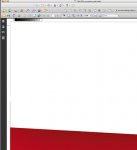Oh you didn't tell us the white shape had a drop shadow applied in indesign

If you look at the two as line art you will see in the postscript there is a large white object with a clipping mask. In the file from indesign you have just one shape a "pathfinder" function has been preformed to remove excess object.
You will also always get maths happening as you down sample, and some how the downsampling will be to a grid. the line is less than 1/2 a pixel (if ppi is 72)
now one more thing, if you look at the two files in illustrator you will se a structural difference.
The indesign file is a bitmap has a clipping path and is then in a group.

In the post script version of this
The bitmap is
…has a clipping path and is then in a group.
…that has a clipping path and is then in a group
…that has a clipping path and is then in a group
…that has a clipping path and is then in a group
...that has a clipping path and is then in a group

Yes, five levels of groups and clipping paths. (for each atomic region)
Now a drop shadow on the edge of an object would only appear like this on a bleed, sinse else you would have a clipping path around white object, and background or the shadow would protrude.
You are asking why is edge of the bleed not rendered in export, well it is not the artwork, that is what the bleed is for. Postscript does not have bleed boxes by definition, and therefore these will be another level of clipping paths. where all within the artbox is rendered meticulously, including irrelevant information such as downsampled details in the bleed, at the expense of making irrationally complex structure. (I remember the times we had to ungroup groups to get them through the rips).
It is to me an explanation of how those coding must draw the line some where to get rational code and it is up to us to understand those boundaries in which we are to work. In this simple file it seems like a bad decision, but remember the rip needs to render things that are invisible in a file, and had there been lotts of detail outside the bleed you would find that the decision to do away with what is outside the bleed (or should we say aputate since we are talking about bleeding? ;P) is on the whole a good one.














